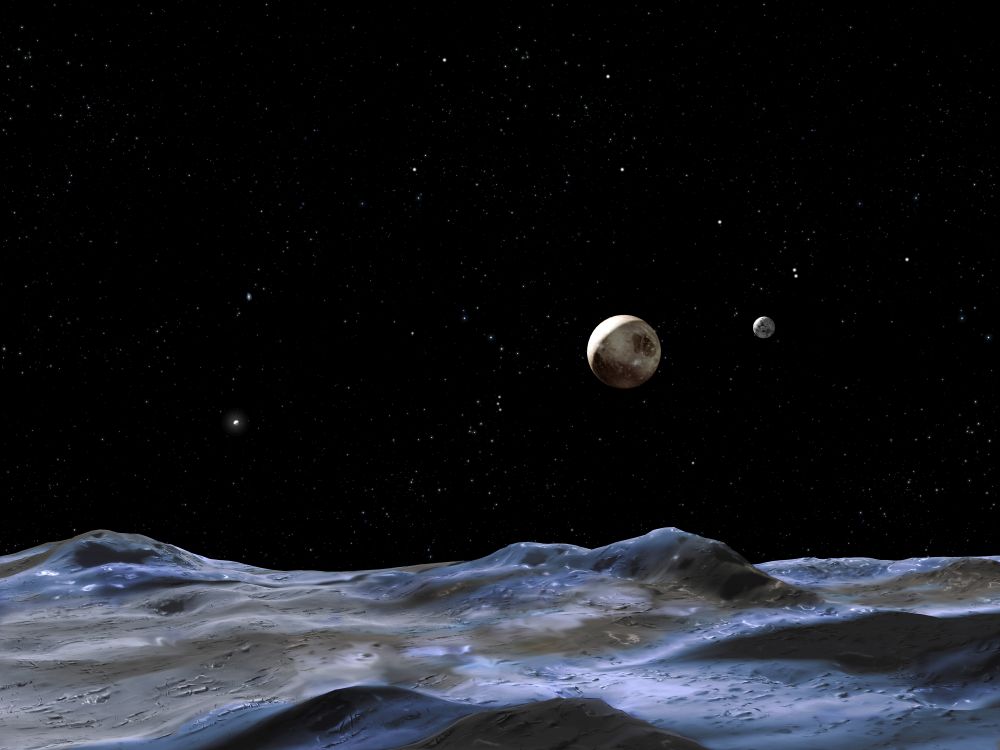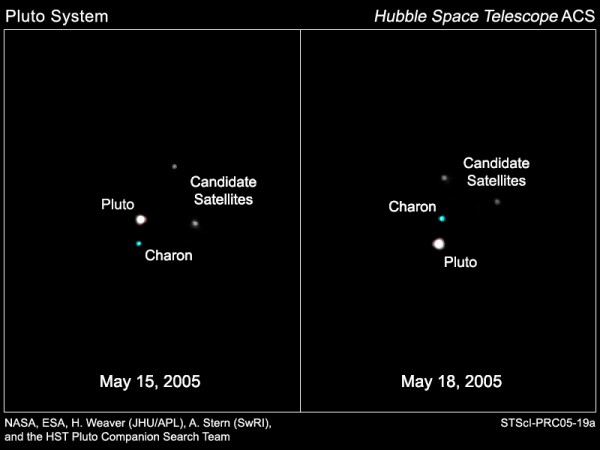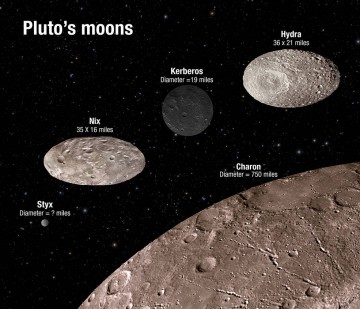
Three weeks now remain before NASA’s New Horizons spacecraft—launched in January 2006—sweeps past the dwarf world Pluto, its large binary companion Charon, and at least four tiny moons, reaching the climax of a 9.5-year voyage to unveil a group of the farthest celestial bodies on what has been routinely described as the “ragged edge” of the Solar System. By so doing, New Horizons will bring full-circle our species’ first-time exploration of each of the traditionally accepted nine planets in the Sun’s realm. Although Pluto has long since been formally demoted to the status of a dwarf planet, a trans-Neptunian object, and the largest body in the Kuiper Belt, fierce debate still rages over its nature. Over the coming days and weeks, AmericaSpace’s New Horizons Tracker and a series of articles by Mike Killian, Leonidas Papadopoulos, and myself will cover the discovery and exploration of Pluto to date, the trials and troubles faced by those who desired to send a spacecraft there, and the unfolding developments as New Horizons seeks to make this unknown world known.
As described in last weekend’s Pluto history articles, the discovery of the diminutive world by U.S. astronomer Clyde Tombaugh in February 1930—and its subsequent naming by English schoolgirl Venetia Burney in honor of the ancient Greek god of the underworld—was followed by several decades of Earth-based observations, which steadily revised estimates of its size and mass in a downward direction. The telescopic discovery of a large moon, Charon, in the summer of 1978, came as something of a surprise, and a series of mutual eclipses throughout the latter half of the 1980s provided astronomers with the ability to derive insights into the composition and mass of the two worlds. In fact, the Pluto-Charon system turned out to be less of a “planet-moon” partnership and more of a pairing of binary companions, neither of which revolved about the other, but rather whose orbital “barycenter” existed outside of both of them.
Until a decade ago, the Pluto-Charon system was so far from the Sun—occupying a highly elliptical orbit, which carries it out of the ecliptic plane, ranging as close as 30 Astronomical Units (2.7 billion miles or 4.4 billion km) and as far as 49 AU (4.6 billion miles or 7.4 billion km)—that very little else could possibly be discerned with certainly, save through the observations of the Hubble Space Telescope (HST). Imagery from this Earth-circling observatory’s Faint Object Camera (FOC) and Advanced Camera for Surveys (ACS) in the 1990s and 2000s revealed tantalizing clues of broad albedo differences across the Plutonian surface, with much speculation that it might well be one of the most contrasting celestial bodies in the Solar System, after our blue and white Earth and the strange, two-toned Saturnian moon, Iapetus. Until just a few weeks ago, HST’s imagery was the best resolution of Pluto attainable by humanity, but the iconic telescope lost that crown in mid-May 2015 as New Horizons’ long, lonely journey through the outer Solar System brought it ever closer to its 14 July rendezvous with the dwarf world and its system of moons.

And that system of moons has grown exponentially over the past decade and may grow still larger as New Horizons draws nearer. It was almost 10 years ago, in October 2005, that Hubble’s ACS detected two small objects in orbit around Pluto, which made it the first known celestial body within the Kuiper Belt to possess more than a single moon. A re-examination of HST data from June 2002 by the Pluto Companion Search Team confirmed the presence of the two moons at their predicted locations. The search sought to identify objects of 27th magnitude, as much as 100,000 times fainter than Pluto itself. Initially named “S/2005 P1” and “S/2005 P2,” the objects were observed about 30,000 miles (48,000 km) and 40,000 miles (64,000 km) from Pluto, which was between two and three times further than the approximate 12,100-mile (19,600-km) position of Charon. Their intrinsically dark nature—about 5,000 times fainter than Pluto itself—required multiple HST observations, which served to ascertain their presence and determine that they were in orbit around their diminutive host.
Follow-up studies culminated in an article in the journal Nature in February 2006, which confirmed their existence and characterized their orbits in the same plane as their larger sibling, Charon. The latter strongly suggested that both moons were not captured objects, but were created, alongside Charon, possibly in the titanic consequence of a large collision between a pair of Pluto-sized bodies, more than four billion years ago. “Astronomers believe that the formation of the Pluto system is similar to that of our Earth and Moon,” NASA explained in a February 2006 news release. “In both cases, a comparable-sized body slammed into the parent planet. Simulations show that debris from the collision would go into an orbit around the planet and coalesce to form one or more satellites. Investigating how Pluto ended up with three moons, while the Earth has only one should yield valuable insights into the processes by which satellite systems form around planets.”
The discovery team also explored the possibility of additional moons. “These Hubble images represent the most sensitive search yet for objects around Pluto,” explained post-doctoral research student Andrew Steffl of the Southwest Research Institute (SwRI), based in San Antonio, Texas. “It is unlikely that there are any other moons larger than about ten miles (16 km) across in the Pluto system.” Several months later, in June 2006, the new moons were named “Nix” (S/2005 P2) and “Hydra” (S/2005 P1). Both names were wholly appropriate and in keeping with the nomenclature of both Pluto and Charon, which respectively honored the ancient Greek and Roman god of the underworld and the mysterious boatman, who ferried the souls of the departed across the River Styx to Hades, the land of the dead.

In classical mythology, “Nyx” was the shadowy goddess of the night, and the mother of Charon, but since the near-Earth Amor and Mars-crossing Asteroid 3908 already bore the Greek name Nyx, the International Astronomical Union (IAU) opted to utilize the Egyptian equivalent, Nix, for the Plutonian moon. Fittingly, Nyx was also born of Chaos, the primeval void, which existed before anything else came into being. Meanwhile, “Hydra” was the nine-headed serpent—of poisonous breath and virulent blood—which guarded the gateway into Hades. “You’re going to be hearing a lot more about Nix and Hydra in coming years,” said Dr. Alan Stern of SwRI, New Horizons’ principal investigator. “Astronomers are already applying for [HST] time to study their orbits and physical properties. And when New Horizons flies by Pluto in the summer of 2015, each moon will be mapped in detail.”
In fact, Nix promises to garner the most impressive images from the spacecraft, after Pluto and Charon themselves, since New Horizons is expected to acquire imagery with a resolution as fine as 1,500 feet (460 meters) per pixel. This should unveil substantial data about this tiny world, whose surface color may be reddish in nature, or perhaps grey-white, but which takes the form of an elongated football, with approximate dimensions of some 34.9 miles (56.3 km) x 15.9 miles (25.7 km). New Horizons will pass the brighter Hydra—whose orbit carries it farther from Pluto—at a somewhat greater distance, with imaging resolution not anticipated to be much higher than about 0.6 miles (1.1 km) per pixel.
Five years after the confirmation of Nix and Hydra, a fourth Plutonian moon was discovered, lying between the orbits of the two tiny worlds. In July 2011, investigations into the possibility of rings around the dwarf planet using HST’s Wide Field Camera-3 (WFC-3) uncovered a tiny world, no larger than 8-21 miles (13-34 km) in diameter. Initially designated “P4” (as Pluto’s fourth-discovered moon), as well as the official IAU nomenclature of “S/2011 1,” it had not been seen in earlier HST images, because the exposure times were shorter. Naming conventions for the new world were important and lead contender “Vulcan”—proposed and lobbied by Star Trek’s William Shatner—was ultimately dismissed in favor of “Kerberos,” the Greek spelling of the Latin Cerberus, the three-headed hell-hound, responsible for guarding Hades to prevent the living from entering the underworld and to stop the dead from escaping.
Ten times fainter than Nix, Kerberos became Pluto’s smallest known moon, though not for long. Exactly a year later, in July 2012, an even smaller object was found. Measuring just 6-16 miles (10-25 km) in diameter, it occupied a circular orbit around its larger host and was assumed to be co-planar with the other moons, Charon, Nix, Hydra, and Kerberos. “The moons form a series of neatly nested dolls, a bit like Russian dolls,” said team leader Dr. Mark Showalter of the SETI Institute in Mountain View, Calif., following the discovery. The fifth moon was named “Styx” by the IAU in July 2013, in recognition of one of the five rivers which converged on the center of the ancient underworld.
Less than three weeks ago, on 3 June 2015, the truly chaotic nature of the moons’ orbits was revealed through HST observations. The football-shaped appearance of Nix and Hydra contributed to a dynamic rotation, exacerbated by the dynamically shifting gravitational field created by the Pluto-Charon binary system. “By contrast, Earth’s Moon keeps the same face toward us, because the gravitational forces between Earth and the Moon cause the Moon to dynamically settle into a condition called ‘tidal lock’, where it keeps on hemisphere facing Earth,” NASA explained in a news release. “Almost all of the Solar System’s major moons also behave similarly. But the Pluto moons essentially orbit a double planet.”
“Prior to the Hubble observations, nobody appreciated the intricate dynamics of the Pluto system,” said Dr. Mark Showalter. “Our report provides important new constraints on the sequence of events that led to the formation of the system.” HST also revealed that Kerberos is as dark as a charcoal briquette, whilst its fellows are as bright as white sand—a curiosity which will surely form a focus of the New Horizons encounter. Moreover, the sheer chaos of the Plutonian system promises to offer significant insights into how planets orbiting a binary star might operate. In fact, chaos may be a common mechanism in the constitution of such binary systems and, perhaps, may carry profound implications for life.
The second part of this article will appear tomorrow, focusing upon plans for missions to Pluto and the selection of New Horizons.
Stay with AmericaSpace for regular updates and LIVE COVERAGE of New Horizons’ approach and flyby of the Pluto system.
Missions » New Horizons »




2 Comments
2 Pings & Trackbacks
Pingback:More Details on Pluto and Charon Emerge in Latest Images, As New Horizons Begins Approach Phase 3 « AmericaSpace
Pingback:‘We’re Working It, Folks': New Horizons Experiences Communications Loss, Ten Days Out From Pluto « AmericaSpace